Country estate Molenbosch
From our house on Prinses Marijkelaan, we drive to Molenbosch every day. Via the entrance next to the De Oldenborgh senior flat on Arnhemse Bovenweg, we walk along a narrow and densely rowed path into the forest.
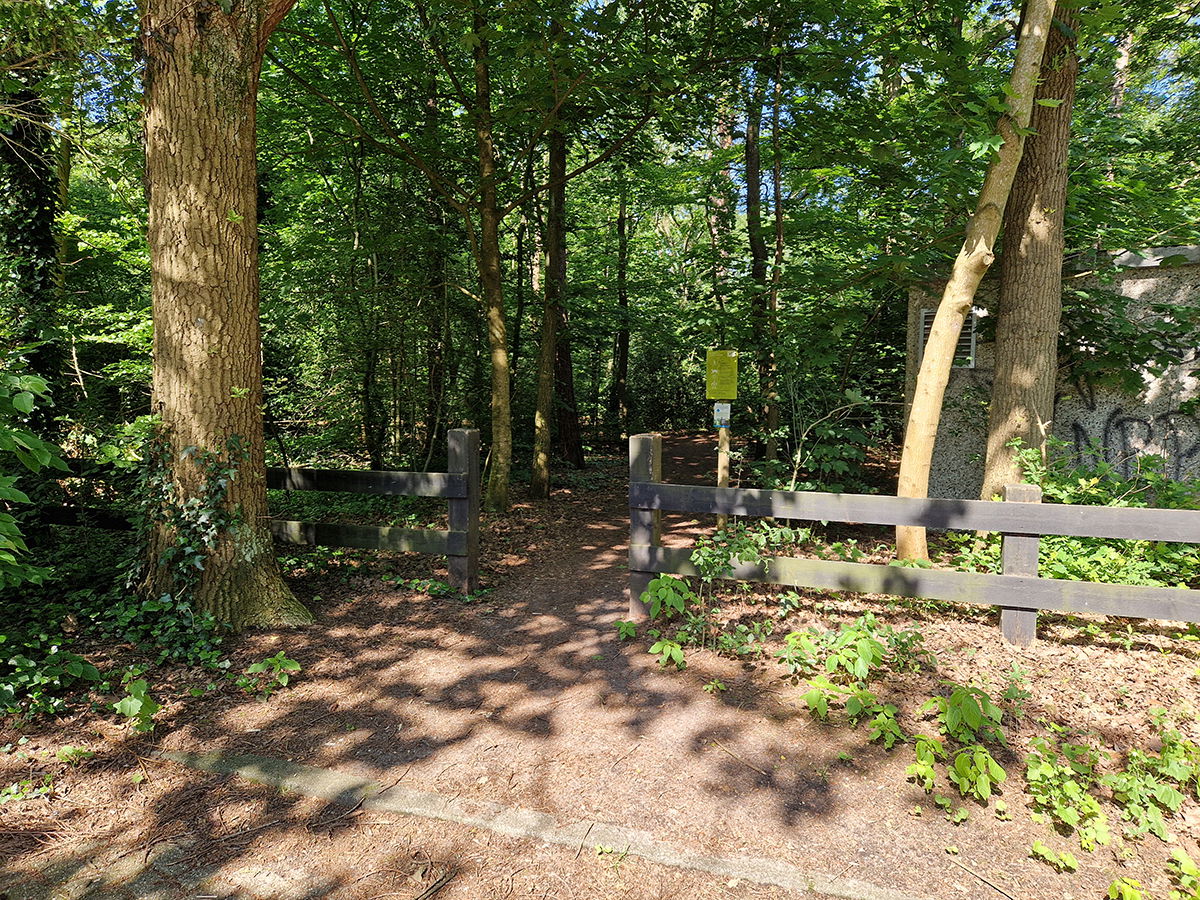
Here too, I am greeted by a robin, I hear the song thrush and the drumming of a woodpecker. Molenbosch is a true bird paradise and it smells so good. I have already experienced a number of “moments of happiness” here.
Last summer, floating and circling on the thermals, first 1 and then about 34 storks came over and this spring 15 cranes on their way to their breeding environment. What a sound and what a beautiful sight.
If I am lucky, I see and hear bird species here that you do not see every day. The willow warbler, rook, redwing, blackcap, marsh siskin, tawny owl, hawfinch, nuthatch, tree creeper, white wagtail, hawk, sparrowhawk, an almost white buzzard, ring-necked parakeets from the direction of the Driebergseweg I hear the cuckoo. Every season, day and time the species and the numbers are variable.
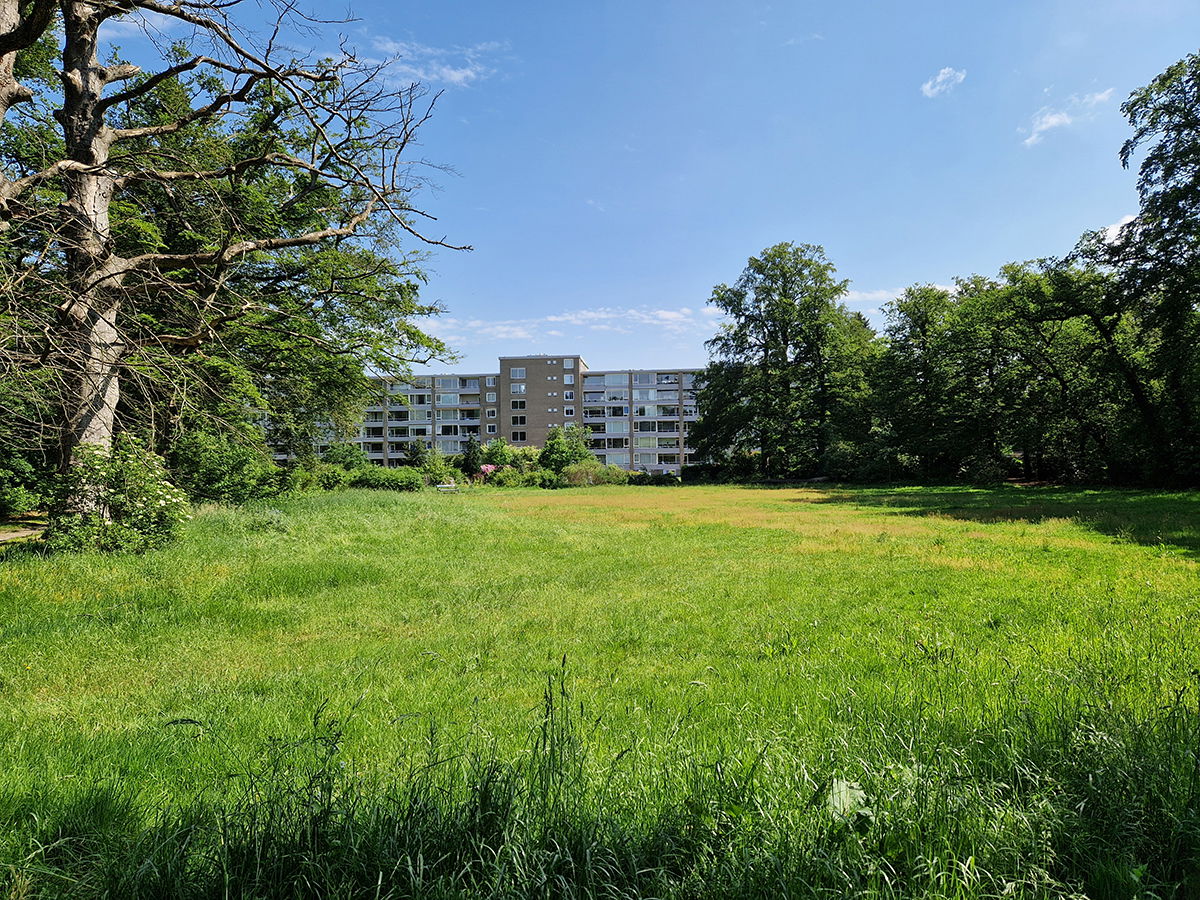
To my right, opposite the house Molenbosch is the Midland apartment complex where about 50 years ago, when it was still a service flat and I was still at school, I helped in the kitchen to cook the food in enormous kettles and then serve it. I walked past doors through long corridors, rang the bell after which a hatch opened and I slid a tray with a tasty meal inside. To my mind at the time this was an elderly prison and the food smelled and tasted the same every day.
Nursing homes
At that time, the Arnhemse Bovenweg was a series of nursing homes and retirement homes. From the Laan van Beek en Royen on the right, you first got Amandelhof, then Simarowa, Mirtehof, later also De Bladerkroon, then Midland, De Oldenborgh, Nijenhove, In De Dennen, Hospice Heuvelrug, Bovenwegen and Heerewegen.
Elderly people from all over the Netherlands wanted to spend their last years here. Now they are mostly owner-occupied and rental apartment complexes. Yes, it was and is a complex. More than a kilometre long and about 650 homes.
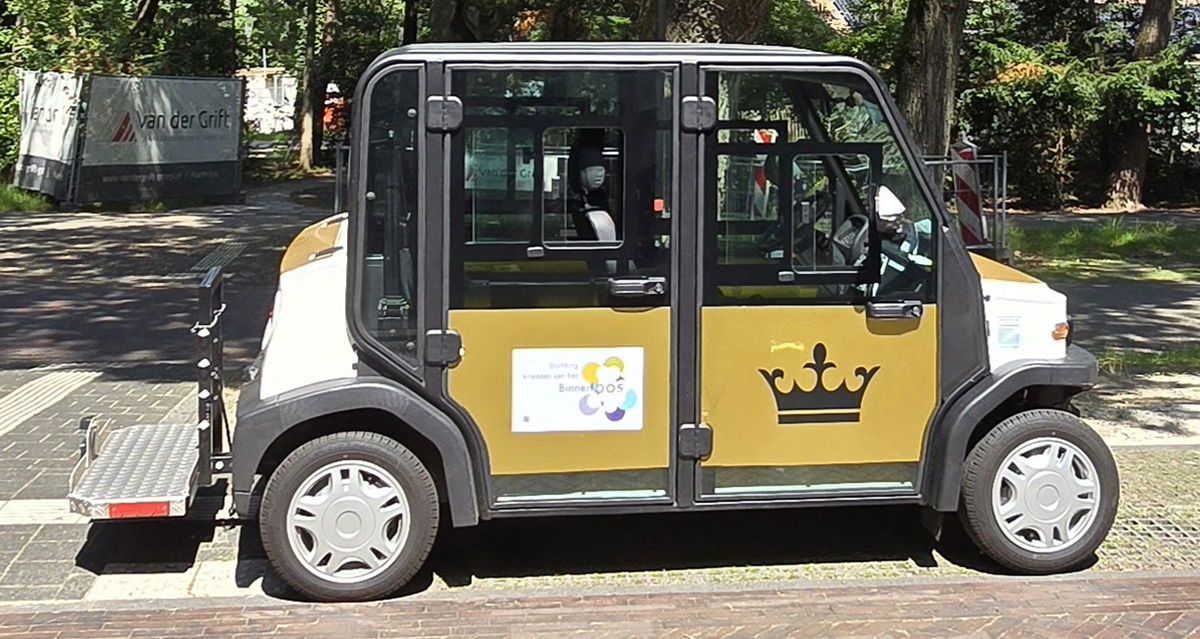
Since April this year I have been a driver on “De Gouden Koets”. With this carriage, “Vrienden van het Binnenbos” bring elderly people out of their isolation. A large part of our (potential) customer base lives on the Arnhemse Bovenweg. Elderly people (also with walkers) from the Kerckebosch district, whom we pick up at home and drive to shops, the market, the Bosrust cemetery, doctors, therapists, the Binnenbos Meeting Centre and back again. Completely free of charge. Call for an appointment 06 143 208 72.
Wild
My dog Siena is allowed to run free, but Giulia stays on the long leash for a while, because she is in a state of high alert. From her posture, head up and tail wagging high, I can see that there is wildlife in the area. We have already come face to face with a fox, hares and deer here. Look, there is a squirrel quickly shooting up a tree. Just recently I saw a lot of badger rooting tracks along the paths. Yes, this one has also been seen a number of times.
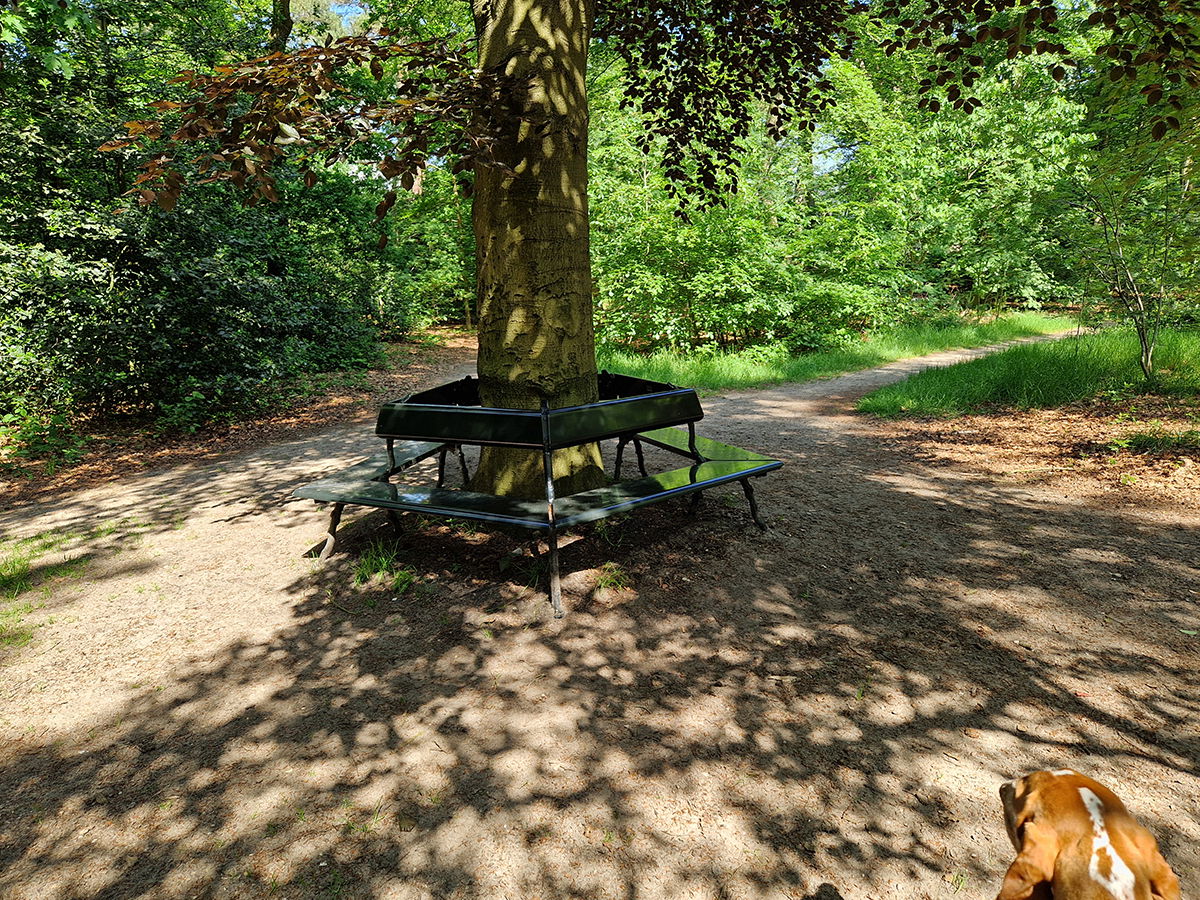
Then I walk further into the forest and turn off to the five-way junction, where an old beech tree with benches around it stands. Turn right to the lawn that lies between the house Molenbosch and Midland, turn left and walk behind De Oldenborgh and Nijenhove and diagonally to the left you walk towards the Heideweg. But we walk straight ahead, along the arch bridge towards the old dying beech, which stands by the water with a view of Het Huis Molenbosch. I sat under the old beech, which was still alive in 2019, for many years with my Bracco Italiano Luna, who died in 2021.
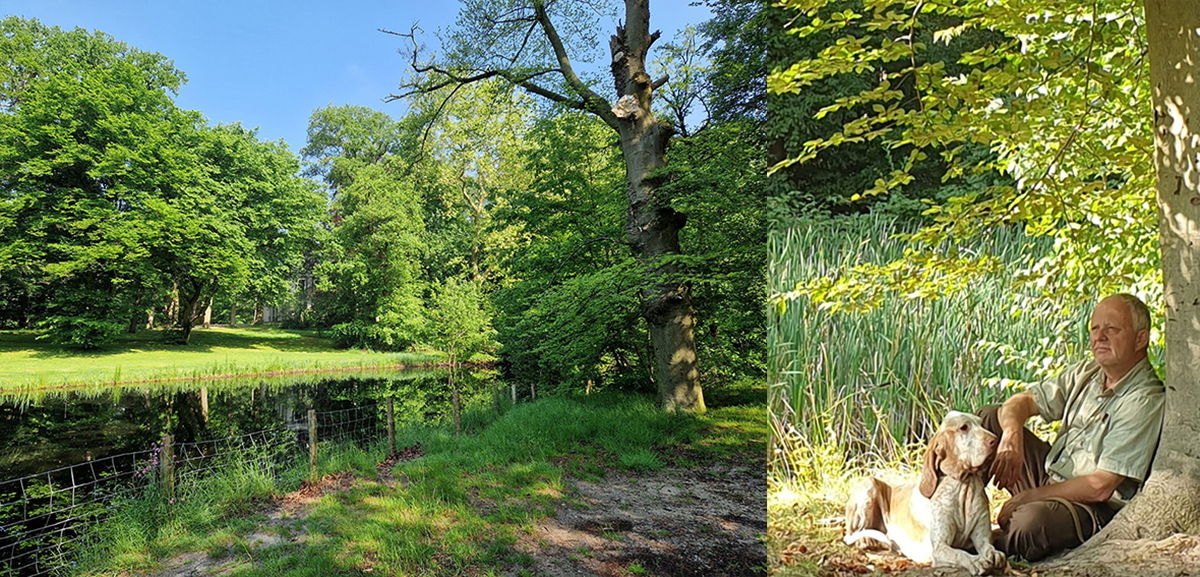
Due to the many long periods of drought, many trees are not doing well. The beeches in the Molenbosch in particular are in poor condition. If you look around and up, you see dead wood everywhere. That is why there are so many species of woodpecker in the Molenbosch. Plenty of food. The great spotted woodpecker, lesser spotted woodpecker, green woodpecker and this spring I saw a pair of black woodpeckers.
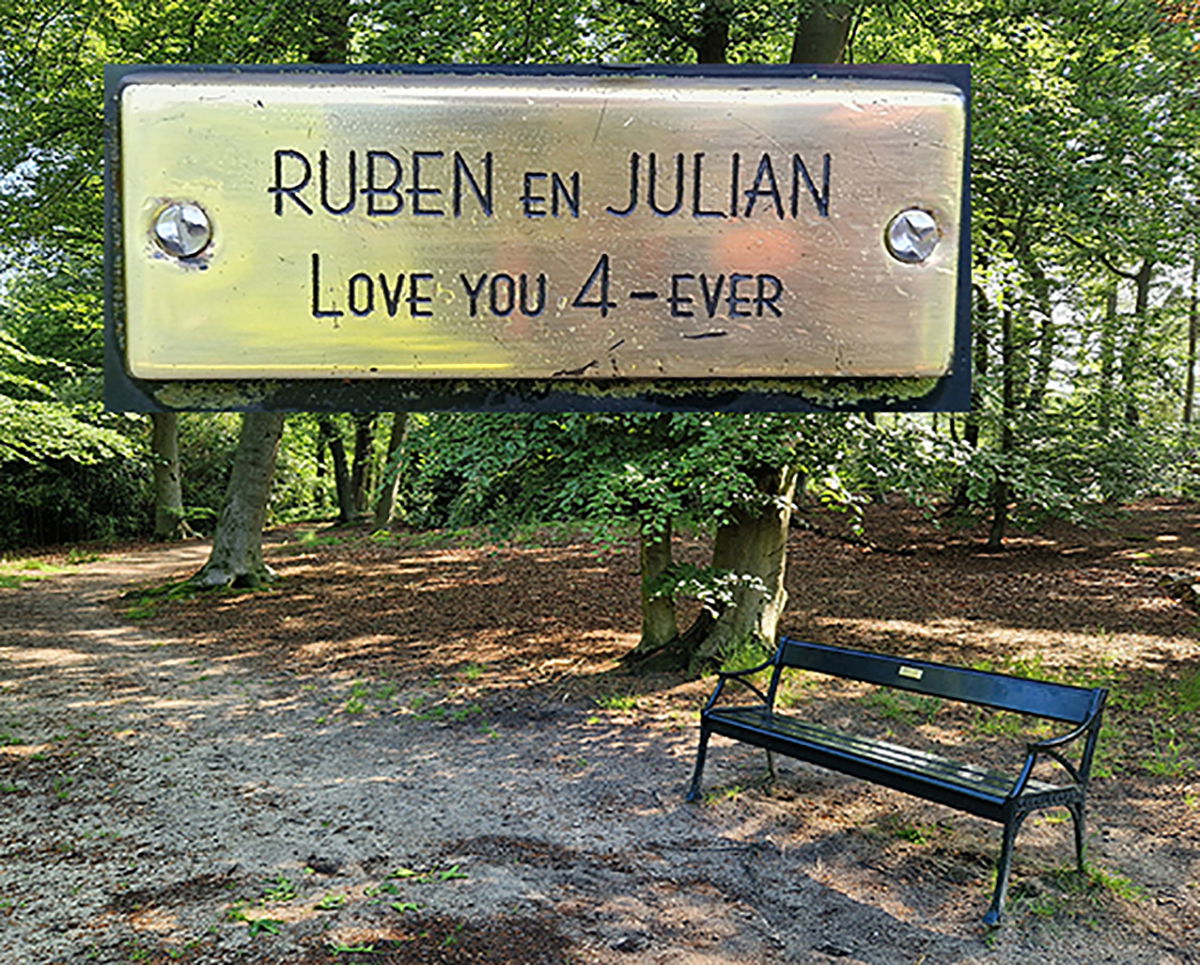
At the old dying beech by the water there is a bench, with a plaque in memory of the brothers Ruben and Julian. I sit down here for a while. In this forest there are a total of nine of these types of benches with memorial plaques, donated by private individuals and organisations. Besides Ruben and Julian's bench, the bench in memory of Miss Annie De Beaufort, under the beeches at the lawn behind the house, is my favorite spot to enjoy the peace, bird sounds and the weather.
One bench really stands out with its text on the memorial plaque. The bench from the Molenweg on the left into the forest "I'm even out of the wind gone to lie down". Great text, isn't it?
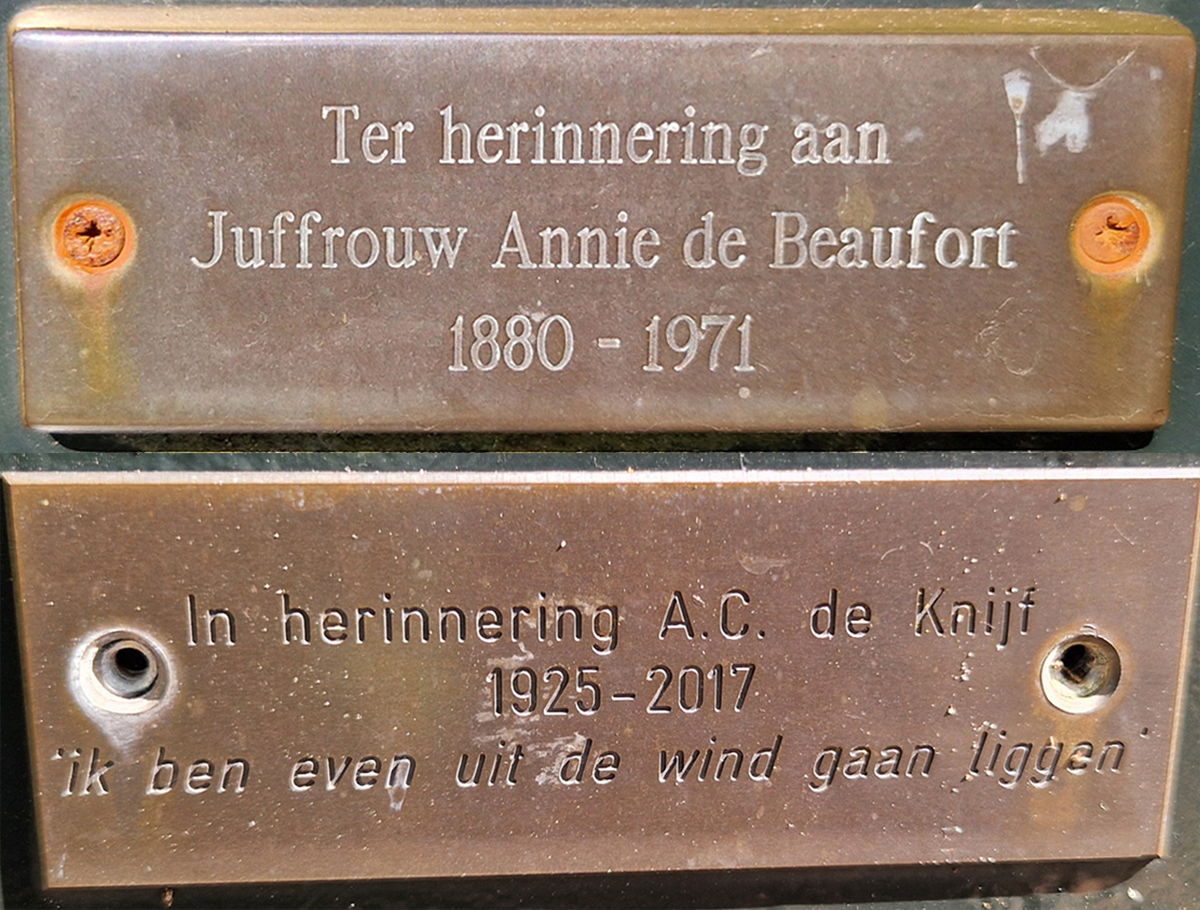
During our walk I pick up a lot of waste. My position is "What you take home full, you can also take back home empty". Many people do not seem to understand that. I hand in the empty deposit bottles and cans at Albert Heijn and donate the proceeds to the described Charity via the donation button.
In the winding ponds you will find many water birds, fish and frogs. This year I have seen the grebe, little grebe, moorhen, coot, grey goose, Canada goose, mallard, mandarin duck, Egyptian goose, cormorant, blue heron and kingfisher. On the way to the house I walk past a walled pit. This used to be the Ice Cellar under a rectangular building with a saddle roof. During the war this building was hit by a bomb. The introduction of the refrigerator made reconstruction unnecessary.
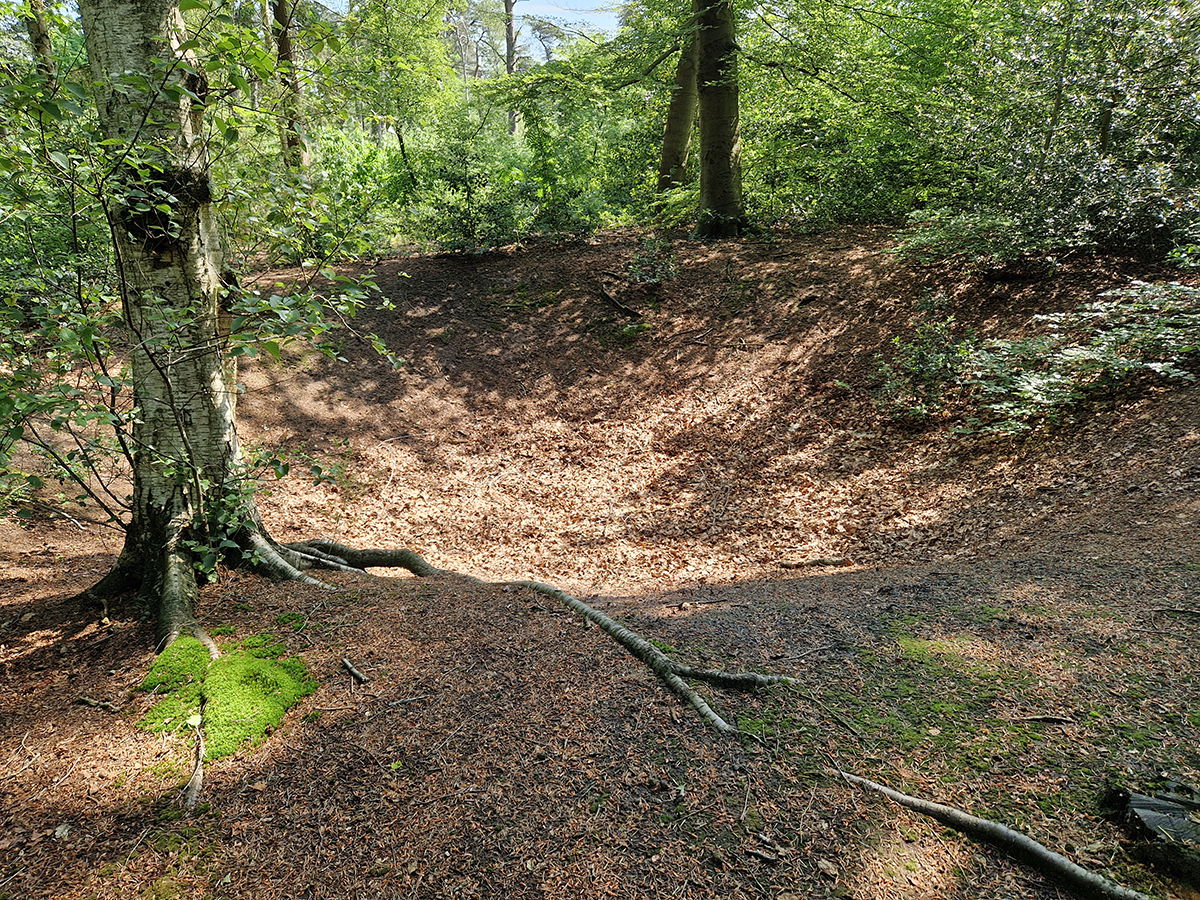
Via a flat bridge we walk over the driveway to the House. In front of the House stands a bronze statue of Miss Annie De Beaufort “looking back at the House” (main photo), made by sculptor Han van den Bosch.
Second World War
At the beginning of the Second World War, the then resident “Anna Wilhelmina Margaretha de Beaufort” (Aunt Annie), received a phone call from the Town Hall with the message to vacate the House and hand it over to the German Wehrmacht. After the war, the House fortunately came back into her possession undamaged.
A small family anecdote: from 1972 to 1975 we lived in Germany, where my father was stationed as an officer of the Royal Air Force at the British Joint Headquarters Rheindahlen. During the annual festive dinner, which the Dutch gave on April 30th in honor of the birthday of our then Queen Juliana for the various occupying powers and German soldiers, a German officer sitting next to my mother asked. “Why are you free on May 4th”. My mother told him that on this date we commemorate our dead from World War II. The German officer asked again: “But why do you have a day off on May 5?” My mother: “Then we celebrate that we chased you out of our country.” Then it became deathly quiet.

We continue walking past the house and I accidentally take a wrong path and suddenly we are standing next to the house where 3 dogs are barking behind a high fence. There comes Mr. (Coos) Van Wageningen walking up and asks kindly, are you on your way to the Chicken Palace? No, I say, I have taken the wrong path and would like to take photos of the house, with your permission.
I tell him that I write pieces about my walks and that the day before I missed the excursion, from Gilde Zeist to visit The Chapel of the Holy Guardian Angels. “Would you like to see the Chapel,” asks Mr. Van Wageningen. “I am just painting the outside.”
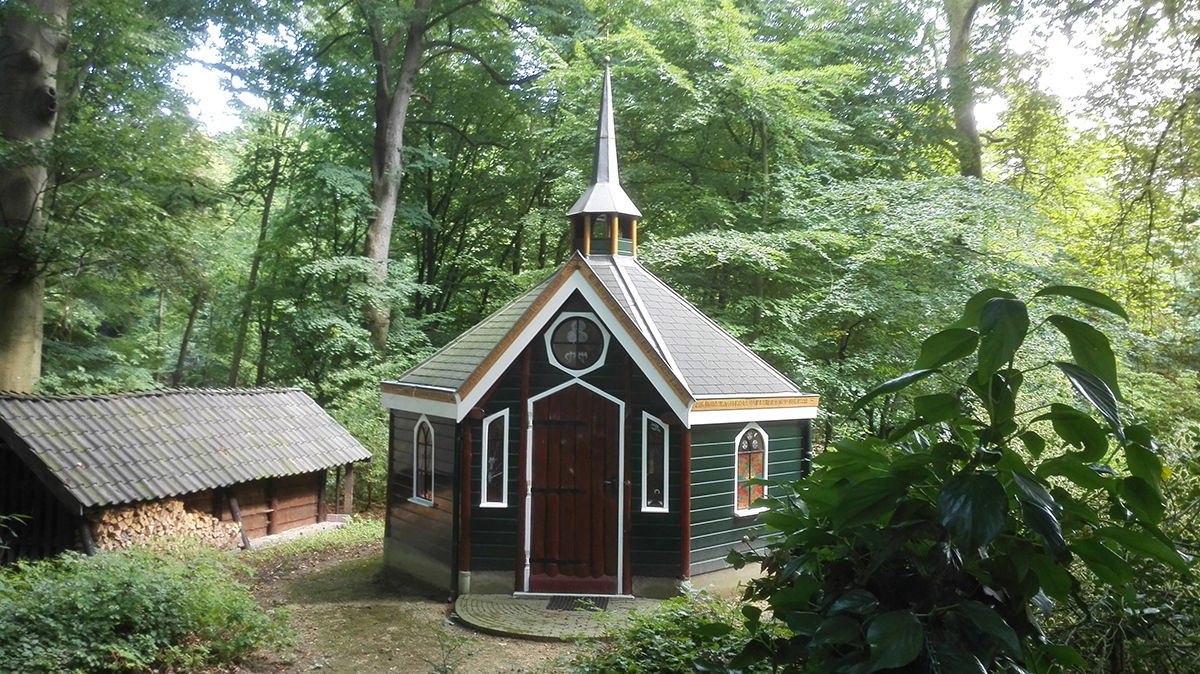
I seize this opportunity for a private tour with both hands and so, through this chance encounter, my long-standing ardent wish to see the inside of the Chapel comes true. But first, Mr. Van Wageningen brings his dogs inside. I will soon write a separate story about the "Chapel of the Holy Guardian Angels".

After visiting this beautiful and intimate chapel, I continue my way and walk around the walled Vegetable Garden. These are now allotments, but in the past, the vegetables and flowers for the residents of Het Huis were grown here. In the Vegetable Cellar next to the vegetable garden, the cultivated vegetables were stored in the dark and cool.
A few years ago I also happened to be in this cellar with its magnificent vaults. At the moment it serves as a home for the whiskered bat, the water bat and the fringe-tailed bat. They fly in and out through a narrow opening in the steel door.
Two years ago, two ladies were peering through the opening and I asked them "do you know what's in that cellar?" When I told them about the bats, they fled as if the devil was on their heels. Haha.
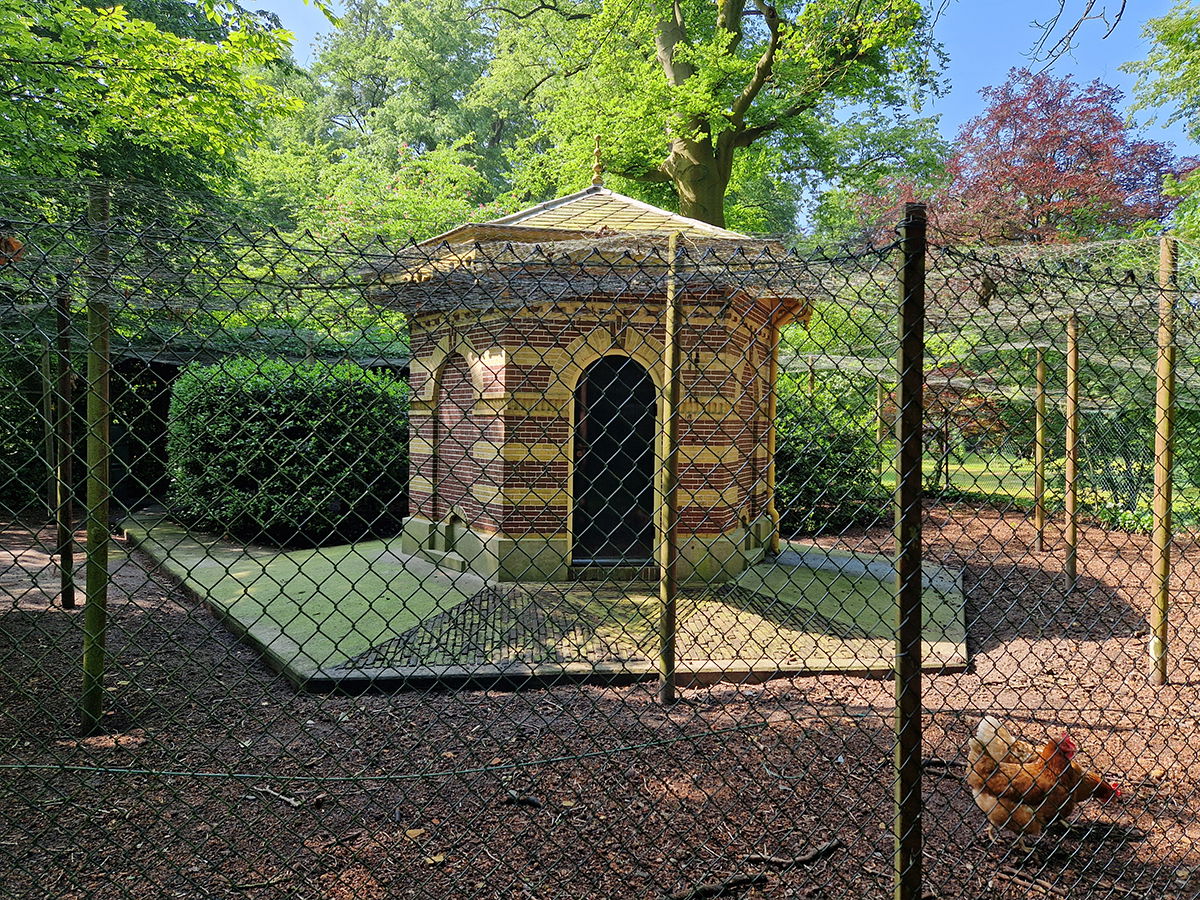
We continue our way and see through the trees on the right, just barely the Coach House with the Horse Stable next to it. Then follows the Chicken Palace, where the chickens can walk around freely behind and under the wire. Yes, Reinaert the Fox has struck here a few times in the past.

At the end of our walk, we arrive at the field that lies behind the House. I remember that in the past there were donkeys, goats, sheep and other animals in the meadow and a few years ago the large field was still a fenced horse meadow. Fortunately, since mid-May this year there have been sheep again.
The dogs can run and play to their heart's content in the field and the owners and residents can enjoy everything that nature and the mill forest have to offer on the memory benches.
You can find many more beautiful photos in the gallery of the website.
Zeist is so beautiful and how lucky we are to live here.
Until the next visit to the Chapel of the Holy Guardian Angels, Arnie Della
You can read my walking stories as well as the columns of other Zeist columnists at https://www.zeistermagazine.nl
Brief overview of Molenbosch Country Estate
The counttry Estate owes its name to a windmill from 1461 that was demolished in 1856.
Addres: Driebergseweg 7
Before 1830 owned by the successive owners of Zeist Castle
1830-1832 Owner: Albert Voombergh (1793-1851) Head of the Amsterdam Banking House Ketwich and Voombergh
1832-1835 Owner: Margaretha van Oosthuyse van Rijsenburg-de Jong, widow of Petrus Jodocus van Oosthuyse van Rijsenburg
1835 Purchase of Het Molenbosch by the Amsterdam banker Johannes Bernardus (also Jan Bernard) Stoop (1781-1856), partner of the banking house Hope & Co. 17 hectares in size for eight thousand guilders. The plot is bordered by the Driebergseweg, the Molenweg, the Arnhemse Bovenweg and a part of the Heideweg.
1836-1837 Transformation of forest plot into landscape park designed by Jan David Zocher (1791-1870)
1837 Construction of Heerenhofstede “Gardener’s house” designed by Jan David Zocher. The first gardener was Jacobus van Achterbergh
1849 laying of the foundation stone by the grandchildren Willem Hendrik (1845-1918) and Wilhelmina Cornelia de Beaufort (1843-1927). Children of Anna Aleida (Anni) de Beaufort - Stoop (1812-1885) and Arnoud Jan de Beaufort (1797-1866) after a design by Jan David Zocher
1854-1855 Coach house, Orangery
1873, Chicken palace and originally also Walled vegetable garden, Vegetable cellar, Ice cellar, Bath house and Flower greenhouse
1898-1951 inhabited as a summer house by Johannes Bernardus Stoop
1856 inhabited by Anna Aleida de Beaufort - Stoop and Arnoud Jan de Beaufort 1885 inhabited by Joachim Ferdinand de Beaufort
1929-1971 inhabited by Anna Wilhelmina Margaretha de Beaufort (aunt Annie)
1940-1945 requisitioned by the German Wehrmacht
1971-2012 inhabited by Digna Wilhelmina Ernestine de Beaufort with her husband Jacob Gerard van Wageningen and her brother Joachim Ferdinand de Beaufort
1962 Transfer of forest to the Municipality of Zeist Everything except the plots that have been built on, that is to say the four service flats and the plots of land on which the coach house, gardener's house, main house, chicken palace and garden arbour stand.
1989 Wooden Chapel Designed, built and furnished by Joachim Ferdinand de Beaufort
1994 Transfer of park to Het Utrechts Landschap
2012 Owners of Het Huis, gardener's house, coach house and land in front and behind: the Van Wageningen family
2017 Restoration of Park Forest with replacement of the wooden arch bridge and flat bridge by steel bridges